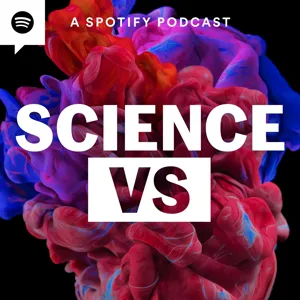Podcast Summary
Discovering the Truth About Fireflies: Fireflies are real beetles that produce light through a chemical reaction in their bodies, contrary to popular belief that they are mythical creatures or fairies.
Fireflies, despite being often mistaken for mythical creatures or fairies, are in fact real insects belonging to the beetle family Lampyridae. Dr. Sarah Lewis, a renowned firefly expert and professor at Tufts University, shared her passion for these glowing creatures during an enlightening conversation on the Ologies podcast. Fireflies are neither flies nor true bugs, but rather beetles, and they produce light through a chemical reaction in their bodies. Their unique ability to light up has captivated people for centuries, earning them a special place in our hearts and minds. Dr. Lewis emphasized the importance of educating the public about the reality of fireflies and their significance, as many people mistakenly believe they are mythical creatures. She also discussed various aspects of firefly biology, conservation, and observation, including their luminous language, population status, and the impact of artificial light on their behavior. Overall, the conversation highlighted the fascination and wonder that fireflies inspire, and the importance of understanding and appreciating the natural world around us.
Discovering the Diversity of Fireflies: Fireflies are diverse creatures with over 2,000 species, varying in size and reproductive priorities, found worldwide, and known for their unique flashing patterns used for communication and mating.
Fireflies are real and diverse creatures, with over 2,000 different species discovered so far. Contrary to some beliefs, they are not nonexistent or one-size-fits-all insects. Fireflies come in various sizes, from tiny ones that can be seen with the naked eye to large, wingless females that can fill a palm. These females are often much bigger than the males and prioritize reproduction over flying. Fireflies are found all over the world, and many people have fond memories of encountering them for the first time during their childhood. Fireflies' unique flashing patterns are used for communication and mating, making them fascinating subjects for further study.
Fireflies' Unique Visual Communication System for Mating: Fireflies' distinct flashing patterns are used for mating, allowing researchers to study their courtship behaviors and preferences through manipulation of signals.
Fireflies use a unique visual communication system for mating, which allows researchers to study their courtship behaviors and preferences in detail. Female fireflies are choosy about whom they respond to, and males compete for their attention by adjusting their flashing patterns. Researchers can manipulate these signals and observe the females' responses, effectively conducting an "opinion poll" to understand their preferences. This system, which is easier to study compared to other insect communication methods like smell or sound, has provided valuable insights into firefly behavior and evolution.
Male fireflies give females nutrient-rich nuptial gifts during mating: Male fireflies provide females with essential nutrients for egg-laying through nuptial gifts, increasing chances of successful reproduction. Females are selective about their mates due to the importance of receiving a large and nutritious gift.
During mating, male fireflies provide females with nutrient-rich nuptial gifts, which are essential for the females to lay more eggs. This elaborate structure, transferred internally during copulation, is a significant investment from the male and increases the chances of successful reproduction. Females are choosy about their mates due to the importance of receiving a large and nutritious nuptial gift. This discovery challenges the common perception of fireflies as simple insects and highlights their complex reproductive behaviors. Additionally, contrary to popular belief, there are indeed fireflies in the western United States, with different species exhibiting unique characteristics such as daytime activity or glowing females.
Misunderstood Fireflies of the Western United States: The Western US hosts diverse firefly species, including the California Pink Glowworm, which defy common beliefs about their existence and behavior as beetles undergoing complete metamorphosis, with females emitting light and larvae as voracious predators
The Western United States is home to various species of fireflies, which have been misunderstood and overlooked due to the common belief that fireflies only exist in the Eastern parts of the country. These fireflies, such as the California Pink Glowworm, have unique characteristics, with the females emitting light to attract males. Fireflies are actually beetles that undergo complete metamorphosis, and while adults are only visible for a short period, they spend most of their lives as larvae, which are voracious predators living in the soil or leaf litter. Recent projects, like the Western Firefly Project, aim to map and study these fireflies through community science observations. It's an exciting discovery that challenges the common perception and broadens our understanding of these fascinating creatures.
Fireflies' remarkable abilities during their larval stage: Fireflies, though small, can paralyze and consume larger prey during their larval stage, which lasts up to two years, and use bioluminescence for defense, camouflage, and attracting prey.
Fireflies, despite their small size, possess a remarkable ability to paralyze and consume larger prey, working together in groups during their larval stage. During this stage, which can last up to two years, they feed and grow, accumulating resources for their short-lived adult stage. Adult fireflies only live a couple of weeks and focus solely on reproduction, spending their accumulated resources on nuptial gifts to attract mates. Fireflies produce light through bioluminescence, a trait that is less common among terrestrial animals and plants but is used for defense, camouflage, and attracting prey, much like in the marine world.
Fireflies' bioluminescence evolved as a warning signal and later turned into a tool for attracting mates: Fireflies originally used their light as a warning signal against predators, but later adapted it for courtship purposes.
Fireflies' bioluminescence, or their ability to produce light, first evolved as a warning signal in juvenile fireflies, who are distasteful due to the toxins they produce. This warning signal, in the form of a flash of light, is more effective than other warning colors in the dark environment. Fireflies' evolutionary history shows that the very first fireflies didn't light up at all, but later on, some adult fireflies co-opted the larval bioluminescence for courtship purposes. So, fireflies started out using their light as a warning signal and later turned it into a tool for attracting mates. If you're curious about fireflies, you might be wondering if clapping or making noise makes them flash, or if catching them and keeping them in a jar is harmful. Fireflies flash in response to threats, so clapping or making noise might be perceived as a disturbance, causing them to flash as a warning signal. Catching fireflies and keeping them in a jar with grass and moisture is generally not harmful, as long as you handle them gently and release them the next day in the same habitat where you caught them.
Fireflies' Defense Mechanisms: Light and Smell: Fireflies protect themselves with distinct odors and toxins, thrive in longer grass habitats, and some species use deception as predatory fireflies
Fireflies have unique defense mechanisms that include both light and smell to protect themselves from predators. Fireflies emit a distinct odor as a warning and release a toxin when handled or attacked. Additionally, longer grass provides moisture and shelter, making it an ideal habitat for fireflies to thrive. Predatory fireflies, such as those in the Photuris genus, use deception and prey on other species to increase their defense against predators. It's important to be mindful when handling fireflies and avoid catching predatory ones, as they can be quite gory. Overall, understanding these defense mechanisms and providing suitable habitats can help encourage more fireflies in our yards and appreciate their unique characteristics.
Creating a Firefly-Friendly Environment: Provide long grass, darkness, moisture, avoid insecticides, and shield lights for fireflies to thrive
Creating a firefly-friendly environment involves leaving your grass long or transforming it into a wildflower meadow, ensuring darkness, providing moisture, and being mindful of insecticide use. Darkness is crucial for firefly courtship, and layers of vegetation can help create hiding spots. Fireflies are insects and are sensitive to broad-spectrum insecticides, which can harm their larvae. If possible, turn off or shield lights during the firefly mating season to give them privacy. Fireflies exhibit different colors due to slight variations in the luciferase enzyme, producing bioluminescence. Blue ghost fireflies, found in the Southeastern United States, are unique glowworms with non-flying females that are earthbound but possess a magical allure.
The Fascinating Blue Ghost Fireflies: Blue ghost fireflies, known for their bluish reflection, actually emit a green glow. Their populations are declining due to habitat loss, light pollution, and insecticides. Protect them by staying on trails and minimizing light and insecticide use.
Blue ghost fireflies are a fascinating yet vulnerable species. These fireflies are called "blue ghosts" due to their bluish appearance when reflected off vegetation, but they actually emit a green glow when recorded with a spectrograph. Their popularity among tourists has led to concerns about habitat destruction and trampling of females and their offspring. Fireflies have good and bad years, but overall, populations are declining worldwide due to habitat loss, light pollution, and insecticides. Habitat specialists are particularly at risk, as they rely on specific habitats for survival. To help preserve firefly populations, it's important to stay on designated trails when viewing them and to minimize light pollution and insecticide use.
Protecting Fireflies: Guidelines and Community Projects: Follow guidelines to minimize impact on fireflies, contribute to research projects, and capture stunning images without disturbing them
Fireflies are facing various threats, including pesticides that harm their larvae, and we can help protect them by following guidelines such as using motion detectors or timers for outdoor lighting, shielding lights, switching to red bulbs or filters, and closing curtains at night. Additionally, community science projects like the Western Firefly Project, New Mexico Firefly Project, and FireflyWatch provide opportunities for people to contribute to firefly research. For those interested in photography, using a tripod, slowing down the shutter speed, opening the lens wide, and increasing the camera's sensitivity to light can help capture good firefly images. Radim Schreiber's Firefly Experience is a recommended resource for stunning firefly photographs taken without any artificial light. Regarding the song "Fireflies" by Owl City, the speaker expressed that they don't particularly care for it due to its lyrics.
Firefly scientist Sarah Lewis discovered her passion through her mother's glowworm song: Firefly scientist Sarah Lewis finds joy and wonder in studying these creatures despite challenges and shares their magic with others.
Sarah Lewis, a firefly scientist, has a deep connection to these bioluminescent insects, which she discovered through her mother's singing of a glowworm song during her childhood. Despite the challenges of working in mosquito-infested environments, Lewis finds great joy and wonder in studying fireflies and sharing their magic with others. Her dedication to the field is evident in her career and her enthusiasm for spreading knowledge about these creatures. Additionally, the Mills Brothers' glowworm song mentioned in the conversation can be found in the show notes, along with links to Lewis's book, website, and social media platforms.
The allure of loose slots in casinos can lead to unpleasant experiences: The pursuit of potential winnings in gambling can sometimes result in disappointment and even disgust, much like eating bad food at a buffet.
The concept of "loose slots" in casinos, which are advertised to attract customers, can sometimes be associated with unpleasant experiences, much like eating bad food at a buffet. This analogy was shared during the conversation, highlighting the disappointment and even disgust that can follow the pursuit of potential winnings. Despite the forgetfulness mentioned, the speaker wanted to convey this idea once again. It's important to remember that while the allure of gambling can be enticing, it may not always result in a positive outcome. Instead, one might end up feeling chained to the jackpot, much like being stuck with a case of food poisoning.






